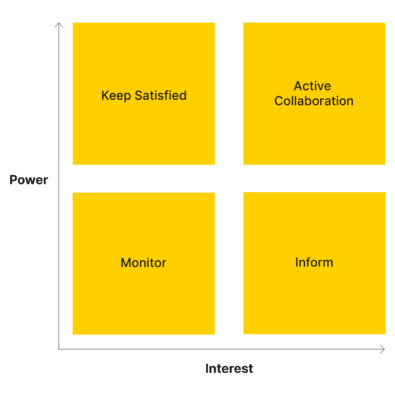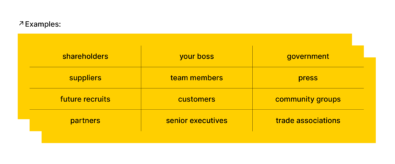Do you embark on a new project?
You will need to have a plan to deal with all the people who have an interest in your project.
If you don't, you run the risk of creating conflict, alienating various interest groups, and slowing progress -- not what you want.
Solution?
Apply stakeholder management.
The goal is to manage everyone with an interest in the project optimally. However, getting it right isn't always easy.
In this blog, you learn:
- What stakeholder management is
- How to identify stakeholders
- How to classify them
- How to communicate with them
Let’s dive right in.
What is Stakeholder Management?
A stakeholder is anyone with a vested interest in the outcome of a project.
Stakeholder management, therefore, is a stakeholder approach that helps you identify:
- who your stakeholders are, and
- how you should communicate with them.
It's a tried-and-tested tool to ensure that you maximise benefits from any stakeholder engagement you undertake.
Understanding your Stakeholders
Stakeholder management plans are one of the first steps of your innovation sprint. They involve understanding the real people behind the customers -- sometimes called "context mapping" -- and dividing the market into different groups to find the best target audience.
Power interest grid
The most crucial part of understanding stakeholders is the use of a power interest grid. These break down stakeholders into different groups based on two dimensions:
- power, and
- interest
4 types of stakeholders
You use this power interest grid to breakdown your stakeholders in 4 categories:
- Keep satisfied: suitable for stakeholders with high power and low interest.
- Active collaboration: suitable for those with high power and high interest.
- Monitor: suitable for those with low power and interest, and
- Inform: for individuals with high interest but low power.
Using this type of stakeholder mapping makes it easier to achieve balance when dealing with stakeholders. It lets you identify the key groups and respond to them accordingly.
For example:
You might identify a neutral person who has a lot of power over the direction of your project or a person who is against a project but has very little power. The stakeholder mapping grid then guides how you interact with them. In the first case, regular engagement is key. In the second, your role is merely to maintain their interest.

How to Create a Stakeholder Management Plan
A stakeholder management plan typically follows the four stages discussed below:
Step 1: Identify your stakeholders
The first step of stakeholder management is to identify who your stakeholders are.
But, how do you do that?
It's actually incredibly easy. Start by getting your team together and brainstorming the most important internal and external project stakeholders. Write down all the people that your project could affect.
Internal stakeholders
Internal stakeholders are individuals who are affiliated with the company. These could include employees, contractors, shareholders, owners, executives, members of the C-suite, and members of the board.
External stakeholders
External stakeholders are people who operate outside of the company, for instance, competitors, local government, customers, suppliers, and financiers.
External stakeholder management is just as important as internal management, if not more so. Those who have an interest in the project outside of the firm often post a higher risk to innovative organisations than those on the inside.
For instance, the press is a critical external stakeholder because it has the power to seriously damage a company's reputation if things go wrong. Community groups are also important for the same reason.

Step 2: Determine how much backing stakeholders will give you
Once you know who your stakeholders are, the next step in stakeholder engagement is to work out how much backing they will give you. A stakeholder management plan should tell you the level of interest of project stakeholders, and how much influence they have over your attempts to move your project forward.
To determine the level of backing you will get from a stakeholder, you need to ask the right questions.
Examples:
Do they have an interest in blocking your project?
Are they emotionally invested in your project?
Are there people putting pressure on them to block or support your project?
Can they provide you with helpful information about the project?
Do they have expectations and demands about how a project should turn out?
Will they be affected by the project personally?
Have you had problems with them in the past?
What type of information about the project can they give you?
Once you have the answers to your questions, arrange stakeholders according to their level of support.
If you find it easier, you can colour code them depending on whether they are for or against the project. We suggest you label them green for advocates, orange for neutrals, and red for each stakeholder actively looking to block you.

Step 3: Map them into your power-interest grid
Once you know who your stakeholders are and whether they support you, the next step is to map each stakeholder onto your power-interest grid (also called a stakeholder matrix). Doing this shows you the extent to which you need to keep them informed.
Power
First, consider the "power" of the stakeholder. Most stakeholder management plans break this down into "formal" and "informal" power.
Formal power refers to someone in an official position within the organisation.
For example, the CEO has the most power. Next on down the list are senior management, then middle management.
Informal power is a little more interesting. It refers to stakeholders with unofficial influence or social influence. They might not have a senior rank, but they could influence stakeholders on certain issues.
For instance, there might be a salesperson on your team who is responsible for a large chunk of the company's revenue. Even though they occupy a low rank officially, unofficially they call the shots because everyone else depends on them for their jobs.
Interest
Second, consider the "interest" of the stakeholder. Interest runs on a scale from highly enthusiastic about your project all the way to "deeply concerned" or against it.
In stakeholder management, it is a stakeholder's interest that matters most to you. The more supportive of a project they are, the more likely it is to go ahead.

Step 4: Build your communication strategy
Stakeholder relationship management requires effective communication. Once you've completed your stakeholder analysis, you need to find suitable ways to engage them.
Therefore, the final step is to use the information you've collected to build your communication strategy.
Any strategic management you undertake should provide the right amount of attention to the stakeholder while also taking an appropriate form. This way, you can save time while also being respectful of the position and status of the stakeholder.
There are many forms that your communication could take, depending on the stakeholder relationship. These include:
Quick text conversations
Formal meeting alongside board members or senior executives
Email newsletters
Annual company meetings
Online webinars and seminars
Internal company news distribution
Planning Your Stakeholder Communications
How you communicate with stakeholders will depend considerably on where they fall on your stakeholder mapping grid.
High Interest, High Power
These individuals have a high interest in how the project turns out, and also considerable sway over how it proceeds. Communication with these individuals should take the form of active collaboration involving upper management. You'll want to work with these people on defining basic aspects of the project, such as milestones, budget, and strategy.
High interest, high power stakeholders require intensive communication. Try to limit how many you allow to influence the project. More than five could result in deadlock.
High Interest, Low Power
Stakeholders in this bracket don't have much sway over the direction of the project but are heavily influenced by the results. Community groups are a good example.
Effective stakeholder management for these individuals could constitute social media posts, newsletters, and blogs. You could improve your stakeholder management by talking to them in person. However, this type of communication could be risky or time-consuming, depending on the project.
Low Interest, High Power
Low interest, high power stakeholders are more common than you might think in project management.
The primary goal here is to keep them satisfied. You don't need to invest a lot of time in making them happy, but it helps to keep them apprised of key metrics that might appeal to them.
Meet with them and use your political skill to demonstrate why they should support your project.
Low Interest, Low Power
People with low interest and low power aren't interested in the outcome of the project and they can't influence it much.
However, good stakeholder management still monitors these individuals. While they might not have an interest right now, they could develop one in the future.
Suitable communication with these individuals could be via the occasional newsletter, blog post, or informative article sent to their email inbox.
Takeaway
Stakeholder management is a critical tool for ensuring that your projects go to plan. Without effective stakeholder analysis, you won't know where and how to communicate with them. However, if you invest in strategic management and stakeholder engagement, you stand a much better chance of operating efficiently while keeping other stakeholders happy.
